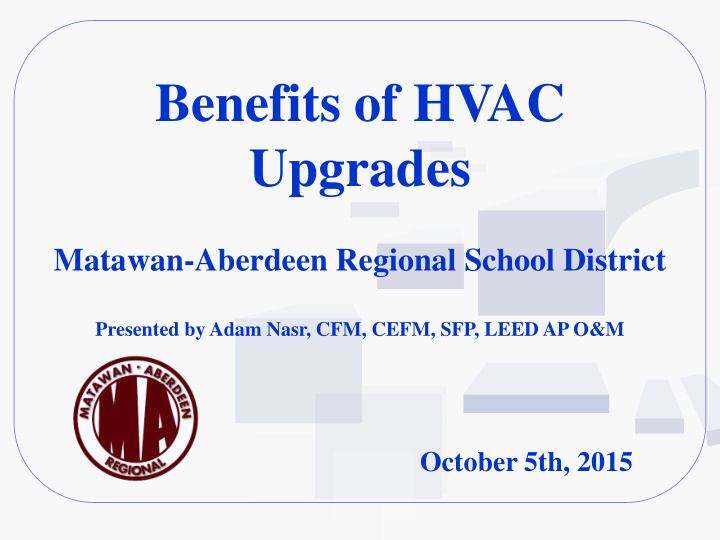



Benefits of HVAC Upgrades Matawan-Aberdeen Regional School District Presented by Adam Nasr, CFM, CEFM, SFP, LEED AP O&M October 5th, 2015
Sustainability • What is sustainability? a. Sustainable development and projects aim to meet the needs of the present without compromising the ability of future generations to meet their own needs. • Using this model, how does a HVAC project promote sustainability?
The Triple Bottom Line (3BL) Model
Environmental Factors The proposed systems will be required to bring the district up to ASHRAE Standard 62 which sets the standard for acceptable indoor air quality.
Social Factors More and more IEPs, 504s, and reasonable accommodation requests are requiring A/C which have to be purchased and installed. More air conditioned spaces open up availability for special education programs, allowing the district to remain competitive with off site providers and also allows the district to stay open longer making it a more attractive venue for event use. Students in classrooms with higher outdoor air ventilation rates scored 14 to 15 percent higher on standardized test scores than children in classrooms with lower outdoor air ventilation rates. (1) Current ASHRAE standards create better IAQ which has been proven to be beneficial for reducing asthma symptoms and a tool in reducing absenteeism by, but not limited to, reducing the risk of airborne infection. Temperatures at the warm end of the comfort zone tend to increase adverse health symptoms, while temperatures at the cool end of the comfort zone tend to reduce symptoms. Similarly, individuals perceive the quality of indoor air to be better when humidity is at the low end of the comfort zone. (2)(3)(4) There is evidence that moderate changes in room temperature (e.g., 77 ° F to 68 °F) affect children’s abilities to perform mental tasks requiring concentration, such as addition, multiplication and sentence comprehension. (5) Overall, cooler temperatures and modest relative humidity conditions have the most positive impact. (6) Children in classrooms with higher outdoor air ventilation rates tend to achieve higher scores on standardized tests in math and reading than children in poorly ventilated classrooms. (7) Studies demonstrate a connection between improvements in IAQ — either from increased outdoor air ventilation rates or from the removal of pollution sources — and improved performance of children and adults. (8)(9)(10)(11)(12)(13) The performance of adults, including teachers and school staff, has also been shown to improve with higher ventilation rates. (14)(15)
References (1) Shaughnessy, R.J., et al. 2006. A preliminary study on the association between ventilation rates in classrooms and student performance. Indoor Air 16(6): 465-468. (2) Fang, L., G. Clausen, and P.O. Fanger . 1998. “Impact of temperature and humidity on the perception of indoor air quality.” Indoor Air 8(2):80-90. (3) Fang, L., G. Clausen, and P.O. Fanger . 1998. “Impact of temperature and humidity on perception of indoor air quality during immediate and longer whole- body exposures.” Indoor Air 8(4):276-284. (4) Fang, L., P. Wargocki , et al. 1999. “Field study on the impact of temperature, humidity and ventilation on perceived air quality.” Proceedings, Indoor Air '99: The 8th International Conference on Indoor Air Quality and Climate. Edinburg, Scotland.2:107-112. (5) Wargocki, P. and D.P. Wyon . 2006. “Research report on effects of HVAC on student performance.” ASHRAE Journal October 2006:22-28. (6) Wargocki, P. and D.P. Wyon . 2007. “The effects of moderately raised classroom temperatures and classroom ventilation rate on the performance of schoolwork by children.” HVAC&R Research 13(2):193-220. (7) Shaughnessy, R., U. Shaughnessy, et al. 2006. “A preliminary study on the association between ventilation rates in classr ooms and student performance.” Indoor Air 16(6):465-468. (8) Myhrvold, A.N., E. Olsen, and O. Lauridsen 1996. “Indoor environment in schools — Pupils health and performance in regard to CO2 concentrations.” Proceedings, Indoor Air '96: The 7th International Conference on Indoor Air Quality and Climate. Nagoya, Japan.4:369-371. (9) Sundell , J. 1994. “On the association between building ventilation characteristics, some indoor environmental exposures, some allerg ic manifestations and subjective symptom reports.” Indoor Air Supplement 2:94. (10) Sundell, J., T. Lindvall , and B. Stenberg. 1991. “Influence of type of ventilation and outdoor airflow rate on the prevalence of SBS symptoms.” Proceedings, IAQ '91 , Healthy Buildings. Conference of the American Society of Heating, Refrigerating, and Air-Conditioning Engineers, Inc. Washington, DC. 85-89. (11) Mendell , M. 1993. “Non - specific symptoms in office workers: A review and summary of the epidemiologic literature.” Indoor Air 3(4):227-236. (12) Seppänen , O., W.J. Fisk, et al. 1999. “Association of ventilation rates and CO2 concentrations with health and other responses in commercial and institutional buildings.” Indoor Air 9(4):226-252. (13) Apte, M., W. Fisk, and J. Daisey . 2000. “Associations between indoor CO2 concentrations and sick building syndrome symptoms in U.S. Office buildings: An analysis of the 1994- 1996 BASE study data.” Indoor Air 10(4):246-257. (14) Wargocki, P., D.P. Wyon , et al. 1999. “Perceived air quality, SBS - symptoms and productivity in an office at two pollution loads.” Proceedings, Indoor Air '99: The 8th International Conference on Indoor Air Quality and Climate. Edinburg, Scotland.2:131-136 . (15) Wargocki, P., D.P. Wyon , et al. 2000. “The effects of outdoor air supply rate in an office on perceived air quality, sick building syndrome (SBS) symptoms and productivity.” Indoor Air 10(4):222-236.
Recommendation Authorize submission of projects to the Department of Education, as well as revision of the LRFP.
Questions
Recommend
More recommend